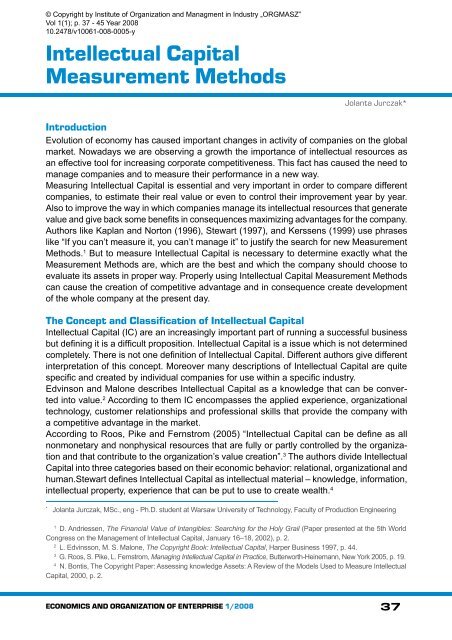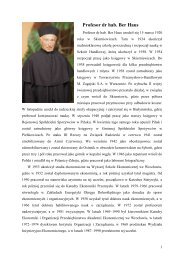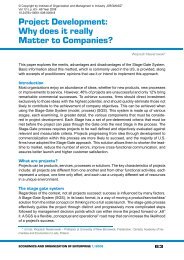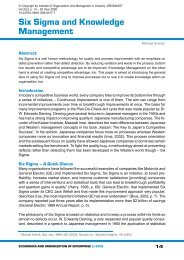Intellectual Capital Measurement Methods
Intellectual Capital Measurement Methods
Intellectual Capital Measurement Methods
Create successful ePaper yourself
Turn your PDF publications into a flip-book with our unique Google optimized e-Paper software.
© Copyright by Institute of Organization and Managment in Industry „ORGMASZ”<br />
Vol 1(1); p. 37 - 45 Year 2008<br />
10.2478/v10061-008-0005-y<br />
<strong>Intellectual</strong> <strong>Capital</strong><br />
<strong>Measurement</strong> <strong>Methods</strong><br />
Jolanta Jurczak*<br />
Introduction<br />
Evolution of economy has caused important changes in activity of companies on the global<br />
market. Nowadays we are observing a growth the importance of intellectual resources as<br />
an effective tool for increasing corporate competitiveness. This fact has caused the need to<br />
manage companies and to measure their performance in a new way.<br />
Measuring <strong>Intellectual</strong> <strong>Capital</strong> is essential and very important in order to compare different<br />
companies, to estimate their real value or even to control their improvement year by year.<br />
Also to improve the way in which companies manage its intellectual resources that generate<br />
value and give back some benefits in consequences maximizing advantages for the company.<br />
Authors like Kaplan and Norton (1996), Stewart (1997), and Kerssens (1999) use phrases<br />
like “If you can’t measure it, you can’t manage it” to justify the search for new <strong>Measurement</strong><br />
<strong>Methods</strong>. 1 But to measure <strong>Intellectual</strong> <strong>Capital</strong> is necessary to determine exactly what the<br />
<strong>Measurement</strong> <strong>Methods</strong> are, which are the best and which the company should choose to<br />
evaluate its assets in proper way. Properly using <strong>Intellectual</strong> <strong>Capital</strong> <strong>Measurement</strong> <strong>Methods</strong><br />
can cause the creation of competitive advantage and in consequence create development<br />
of the whole company at the present day.<br />
The Concept and Classification of <strong>Intellectual</strong> <strong>Capital</strong><br />
<strong>Intellectual</strong> <strong>Capital</strong> (IC) are an increasingly important part of running a successful business<br />
but defining it is a difficult proposition. <strong>Intellectual</strong> <strong>Capital</strong> is a issue which is not determined<br />
completely. There is not one definition of <strong>Intellectual</strong> <strong>Capital</strong>. Different authors give different<br />
interpretation of this concept. Moreover many descriptions of <strong>Intellectual</strong> <strong>Capital</strong> are quite<br />
specific and created by individual companies for use within a specific industry.<br />
Edvinson and Malone describes <strong>Intellectual</strong> <strong>Capital</strong> as a knowledge that can be converted<br />
into value. 2 According to them IC encompasses the applied experience, organizational<br />
technology, customer relationships and professional skills that provide the company with<br />
a competitive advantage in the market.<br />
According to Roos, Pike and Fernstrom (2005) “<strong>Intellectual</strong> <strong>Capital</strong> can be define as all<br />
nonmonetary and nonphysical resources that are fully or partly controlled by the organization<br />
and that contribute to the organization’s value creation”. 3 The authors divide <strong>Intellectual</strong><br />
<strong>Capital</strong> into three categories based on their economic behavior: relational, organizational and<br />
human.Stewart defines <strong>Intellectual</strong> <strong>Capital</strong> as intellectual material – knowledge, information,<br />
intellectual property, experience that can be put to use to create wealth. 4<br />
*<br />
Jolanta Jurczak, MSc., eng - Ph.D. student at Warsaw University of Technology, Faculty of Production Engineering<br />
1<br />
D. Andriessen, The Financial Value of Intangibles: Searching for the Holy Grail (Paper presented at the 5th World<br />
Congress on the Management of <strong>Intellectual</strong> <strong>Capital</strong>, January 16–18, 2002), p. 2.<br />
2<br />
L. Edvinsson, M. S. Malone, The Copyright Book: <strong>Intellectual</strong> <strong>Capital</strong>, Harper Business 1997, p. 44.<br />
3<br />
G. Roos, S. Pike, L. Fernstrom, Managing <strong>Intellectual</strong> <strong>Capital</strong> in Practice, Butterworth-Heinemann, New York 2005, p. 19.<br />
4<br />
N. Bontis, The Copyright Paper: Assessing knowledge Assets: A Review of the Models Used to Measure <strong>Intellectual</strong><br />
<strong>Capital</strong>, 2000, p. 2.<br />
ECONOMICS AND ORGANIZATION OF ENTERPRISE 1/2008<br />
37
<strong>Intellectual</strong> <strong>Capital</strong> <strong>Measurement</strong> <strong>Methods</strong><br />
Bratnicki and Struzyna characterize <strong>Intellectual</strong> <strong>Capital</strong> as the sum of knowledge which<br />
possess people who creates a community of the company and a practical transformation<br />
the knowledge in components. He has divided <strong>Intellectual</strong> <strong>Capital</strong> on components like<br />
organizational and social capital and human capital.<br />
Another definition given by Bukowitz and Williams present <strong>Intellectual</strong> <strong>Capital</strong> in dynamic<br />
way as a form nonmaterial assets, which thanks to flows of knowledge can generate<br />
a potential to create goods. 5 It includes three main elements like: human capital, customer<br />
capital and organizational capital.<br />
Interesting approach to the components of <strong>Intellectual</strong> <strong>Capital</strong> present Grudzewski and<br />
Hejduk, who say that an intelligence of the organization is not a simply sum of intelligence<br />
of it employees but it is a result of existing the synergy phenomenon. The intelligence of<br />
the company is built by different elements like: communications intelligence, technological<br />
intelligence, innovation intelligence, financial intelligence, marketing intelligence, organizational<br />
intelligence, social intelligence and ecological intelligence.<br />
As we can see there are many definition of <strong>Intellectual</strong> <strong>Capital</strong>. These definitions differ each<br />
other in some way but they are not disqualify each other. Most of them present <strong>Intellectual</strong><br />
<strong>Capital</strong> as a knowledge capital or capital which derives from knowledge. Some of them<br />
says that <strong>Intellectual</strong> <strong>Capital</strong> is a intelligence of a organization or a form nonmaterial property.<br />
All presented definition are correct and right because they include all those factors<br />
that are nonfinancial and valuable for a company’s business.<br />
But it’s necessary to notice that not all knowledge constitute the <strong>Intellectual</strong> <strong>Capital</strong>. The<br />
basis of IC is Knowledge which is useful for the company. This knowledge can be <strong>Intellectual</strong><br />
<strong>Capital</strong> then, if we can process and utilize it for the company good. 6 Therefore – basis<br />
of previous definition – <strong>Intellectual</strong> <strong>Capital</strong> can be described simply as all connected<br />
each other Knowledge Resources (material or nonmaterial, tangible or intangible)<br />
that the organization disposes in creating value needed to gaining competitive<br />
advantage in long term . 7<br />
<strong>Intellectual</strong> <strong>Capital</strong> is a complex concept. It possess big and complicated structure, which is<br />
not exactly specified. In order to measure IC, it is necessary to understand the distinguish<br />
between the different components of IC. Detailed structure of IC have been presented in<br />
fig. In the approach <strong>Intellectual</strong> <strong>Capital</strong> can be divided into organizational capital, relational<br />
capital and human capital. Human capital (HC) consists of knowledge capital, competence<br />
capital, attitude and intellectual agility all members of the organization and their ability to<br />
quick taking decisions, cope with the problems and create good interpersonal relationship.<br />
Organizational <strong>Capital</strong> (OC) is dependent on productivity of the organization, its structural<br />
capital, culture and ability to development. It is a kind of investment in systems, tools and<br />
philosophy, which decides about the process of flows knowledge. This capital encompasses:<br />
intellectual property (patents, copyright, licences, trademarks), structural capital (organizational<br />
structure, database or computer equipment), business processes capital (organizational<br />
culture, style of management or software) and market and development capital. Relational<br />
5<br />
W. R. Bukowitz, R. L. Williams, The Knowledge Management Fieldbook, Financial Time, Prentice Hall, London 2000,<br />
s. 223.<br />
6<br />
T. A. Steward, <strong>Intellectual</strong> <strong>Capital</strong>, Bantam Doubleday Dell Publishing Group, New York 1997.<br />
7<br />
Own definition of <strong>Intellectual</strong> <strong>Capital</strong>.<br />
ECONOMICS AND ORGANIZATION OF ENTERPRISE 1/2008<br />
38
<strong>Intellectual</strong> <strong>Capital</strong> <strong>Measurement</strong> <strong>Methods</strong><br />
Figure . Components of <strong>Intellectual</strong> <strong>Capital</strong><br />
Source: own work on the basis of: L. Edvinsson, M. S. Malone, The Copyright Book: <strong>Intellectual</strong> <strong>Capital</strong>, Harper Business 1997 and G. Roos, S. Pike, L. Fernstrom, Managing <strong>Intellectual</strong><br />
<strong>Capital</strong> in Practice, Butterworth-Heinemann, New York 2005.<br />
ECONOMICS AND ORGANIZATION OF ENTERPRISE 1/2008<br />
39
<strong>Intellectual</strong> <strong>Capital</strong> <strong>Measurement</strong> <strong>Methods</strong><br />
<strong>Capital</strong> (RC) concerns connections and relation of the organization with the external environment.<br />
It is value of relationship with customer, strategic partners, employees etc.<br />
The figure shows that physical infrastructure is also a very important part of intellectual<br />
capital of the organization, which differs a bit from definition by Roos, Pike and Fernstrom.<br />
The reason for including physical assets into <strong>Intellectual</strong> <strong>Capital</strong> assets is that they may have<br />
components, such as databases, servers, and physical networks like intranets, which are<br />
based on specific knowledge and the combination of them is unique to one organization.<br />
In the end is necessary to notice that <strong>Intellectual</strong> <strong>Capital</strong> includes both created knowledge all<br />
the organization and its individual participant, their experience, abilities and innovations and<br />
also all the things that support efficiency of work in the organization (computers equipment,<br />
databases, organizational structures, patents, trademarks, licences) but also methods, techniques<br />
or relationships with stakeholders worked out by the organization. These elements<br />
combine and interact with each other in unique way to create value.<br />
Detailing and describing list of all components of the <strong>Intellectual</strong> <strong>Capital</strong> structure is a very<br />
difficult task. <strong>Intellectual</strong> <strong>Capital</strong> structure components are individual for each company. But<br />
if the managers of companies know detailed structure of IC existing in their companies, they<br />
will be aware of size and value intellectual potential, which they possess. It can cause a better<br />
understanding the concept. Than they could choose proper <strong>Measurement</strong> <strong>Methods</strong> and proper<br />
manage their assets. Companies, which learn to measure and manage their <strong>Intellectual</strong><br />
<strong>Capital</strong> in a new way can significant improve their performance in a competitive market.<br />
<strong>Methods</strong> Of Measuring The <strong>Intellectual</strong> <strong>Capital</strong><br />
The interest on managing the <strong>Intellectual</strong> <strong>Capital</strong> has caused the development of different<br />
methods of measuring it.<br />
There are several group of methods of measuring the <strong>Intellectual</strong> <strong>Capital</strong>, which can be used<br />
in order to evaluate this assets. Some of these methods were attempts made by different<br />
companies for their internal use rather than the development of a universal measuring method.<br />
But they still exist and are basis to create new methods.<br />
According to Luthy (1998) and Williams (2000) all methods can be divided into four main<br />
groups: 8<br />
1. Direct <strong>Intellectual</strong> <strong>Capital</strong> <strong>Methods</strong> (DICM) – estimate the dollar value of intangible<br />
assets by identifying its various components. Once these components are identified, they<br />
can be directly evaluated, either individually or as an aggregated coefficient.<br />
2. Market <strong>Capital</strong>ization <strong>Methods</strong> (MCM) – calculate the difference between a company’s<br />
market capitalization and its stockholders’ equity as the value of its intellectual capital<br />
or intangible assets.<br />
3. Return on Assets <strong>Methods</strong> (ROA) average pre-tax earnings of a company and divide<br />
them by the average tangible assets of the company. The result is a company ROA that<br />
is then compared with its industry average. The difference is multiplied by the company’s<br />
average tangible assets to calculate an average annual earning from intangibles. By<br />
dividing the above-average earnings by the company’s weighted average cost of capital<br />
or an interest rate, one can derive an estimate of the value of its intangible assets or<br />
intellectual capital.<br />
4. Scorecard <strong>Methods</strong> (SC) – identify various components of intangible assets or intellectual<br />
capital and indicators and indices are generated and reported in scorecard or<br />
8<br />
http://www.sveiby.com/articles/IntangibleMehtods.html, and G. Roos, S. Pike, L. Fernstrom, op. cit.<br />
ECONOMICS AND ORGANIZATION OF ENTERPRISE 1/2008<br />
40
<strong>Intellectual</strong> <strong>Capital</strong> <strong>Measurement</strong> <strong>Methods</strong><br />
as graphs. SC methods are similar to DIC methods, except that no estimate is made of<br />
the dollar value of intangible assets.<br />
The four main approaches for measuring intangibles (Direct <strong>Intellectual</strong> <strong>Capital</strong> <strong>Methods</strong>,<br />
Market <strong>Capital</strong>ization <strong>Methods</strong>, Return on Assets <strong>Methods</strong> and Scorecard <strong>Methods</strong>) have<br />
various advantages and disadvantages, presented in Table.<br />
Table. Categorization of the IC measurement methodologies with their characteristics<br />
Methodologies<br />
Economic<br />
Value Added<br />
(EVA)<br />
Human<br />
Resource<br />
Costing &<br />
Accounting<br />
(HRCA)<br />
Calculated<br />
Intangible<br />
Value<br />
Knowledge<br />
<strong>Capital</strong><br />
Earnings<br />
Value Added<br />
<strong>Intellectual</strong><br />
Coefficient<br />
(VAIC)<br />
Accounting<br />
for the Future<br />
(AFTF)<br />
Tobin’s q<br />
Investor<br />
Assigned<br />
Market Value<br />
(IAMV)<br />
Originator<br />
and year<br />
of first<br />
publication<br />
Stewart<br />
(1997)<br />
Johansson<br />
(1997)<br />
Stewart<br />
(1997)<br />
Luthy<br />
(1998)<br />
Lev<br />
(1999)<br />
Pulic<br />
(1997)<br />
Nash<br />
(1998)<br />
Stewart<br />
(1997)<br />
Standfield<br />
(1998)<br />
Description<br />
ROA Methodologies<br />
Calculated by adjusting the firm’s disclosed profit<br />
with charges related to intangibles. Changes<br />
in EVA provide an indication of whether the firm’s<br />
intellectual capital is productive or not.<br />
Calculates the hidden impact of HR related costs<br />
which reduce a firm’s profits. <strong>Intellectual</strong> capital is<br />
measured by calculation of the contribution of human<br />
assets held by the company divided by capitalized<br />
salary expenditures.<br />
Calculates the excess return on hard assets, then<br />
uses his figure as a basis for determining the proportion<br />
of return attributable to intangible assets.<br />
Knowledge <strong>Capital</strong> Earnings are calculated as<br />
the portion of normalized earnings over and<br />
above expected earnings attributable to book<br />
asset.<br />
Measures how much and how efficiently intellectual<br />
capital and capital employed create<br />
value based on the relationship to three major<br />
components: capital employed, human capital<br />
and structural capital.<br />
A system of projected discounted cash flows.<br />
The difference between AFTF value at the end<br />
and the beginning of the period is the value added<br />
during the period.<br />
MCM Methodologies<br />
The “q” is the ratio of the stock market value<br />
of the firm divided by the replacement cost of<br />
its assets. Changes in “q” provide a proxy for<br />
measuring effective performance or not of a<br />
firm’s intellectual capital.<br />
Takes the Company’s True Value to be<br />
its stock market value and divides it into<br />
Tangible <strong>Capital</strong>+(Realized <strong>Intellectual</strong><br />
<strong>Capital</strong>+<strong>Intellectual</strong> <strong>Capital</strong> Erosion+SCA (Sustainable<br />
Competitive Advantage)<br />
Characteristics<br />
The ROA approaches have<br />
an element of rigor in that<br />
they rely on financial figures<br />
which, if not perfect, are<br />
auditable.<br />
They attempt real valuations<br />
and may appear useful<br />
in many situations since<br />
they can give crude comparisons<br />
between companies<br />
within the same industry.<br />
However, they give far too<br />
little detail for an adequate<br />
comparison.<br />
The methods are also very<br />
sensitive to interest rate assumptions.<br />
With the exception of VIAC,<br />
these are a means of explaining<br />
a financial feature<br />
and attributing changes in<br />
them to the efficiency in the<br />
deployment of intellectual<br />
capital resources.<br />
These methodologies avoid<br />
direct comparison with market<br />
values but link to some<br />
of the factors that market<br />
makers use in their assessments<br />
of companies.<br />
The MCM approaches also<br />
have an element of rigor in<br />
that they rely on financial<br />
figures which, if not perfect,<br />
are auditable.<br />
They attempt real valuations<br />
and may appear useful<br />
in many situations since<br />
they can give crude comparisons<br />
between companies<br />
ECONOMICS AND ORGANIZATION OF ENTERPRISE 1/2008<br />
41
<strong>Intellectual</strong> <strong>Capital</strong> <strong>Measurement</strong> <strong>Methods</strong><br />
Market-to-<br />
Book Value<br />
Technology<br />
Broker<br />
Citation-<br />
Weighted<br />
Patents<br />
The Value<br />
Explorer<br />
<strong>Intellectual</strong><br />
Asset Valuation<br />
Total Value<br />
Creation,<br />
TVC<br />
Stewart<br />
(1997)<br />
Luthy<br />
(1998)<br />
Brooking<br />
(1996)<br />
Bontis<br />
(1996)<br />
Andriessen<br />
&<br />
Tiessen<br />
(2000)<br />
Sullivan<br />
(2000)<br />
Anderson<br />
&<br />
McLean<br />
(2000)<br />
The value of <strong>Intellectual</strong> <strong>Capital</strong> is considered to<br />
be the difference between the firm’s stock market<br />
value and the company’s book value.<br />
DIC Methodologies<br />
Value of intellectual capital of a firm is assessed<br />
based on diagnostic analysis of a firm’s response<br />
to twenty questions covering four major components<br />
of intellectual capital: Market Assets,<br />
Human-centred Assets, <strong>Intellectual</strong> Property<br />
Assets and Infrastructure Assets.<br />
The base of the develop of the Technology Broker<br />
method is that the market value of a company<br />
is the result of the addition of tangible assets<br />
and the intellectual capital.<br />
A technology factor is calculated based on the<br />
patents developed by a firm. <strong>Intellectual</strong> capital<br />
and its performance is measured based on the<br />
impact of research development efforts on a series<br />
of indices, such as number of patents and<br />
cost of patents to sales turnover, that describe<br />
the firm’s patents.<br />
Accounting methodology proposed by KMPG<br />
for calculating and allocating value to 5 types of<br />
intangibles: 1) Assets and endowments, 2) Skills<br />
& tacit knowledge, 3) Collective values and<br />
norms, 4) Technology and explicit knowledge,<br />
5) Primary and management processes.<br />
Methodology for assessing the value of <strong>Intellectual</strong><br />
Property.<br />
A project initiated by The Canadian Institute of<br />
Chartered Accountants. TVC uses discounted<br />
projected cash-flow to reexamine how events<br />
affect planned activities.<br />
within the same industry.<br />
However, they give far too<br />
little detail for an adequate<br />
comparison.<br />
The DIC is intended to be<br />
holistic and offer the potential<br />
to create a more<br />
comprehensive picture of<br />
an organization’s health<br />
than financial metrics. The<br />
methods are more detailed<br />
and can be easily applied at<br />
any level of an organization.<br />
They measure intellectual<br />
capital resources from the<br />
bottom up and can therefore<br />
be faster and more accurate<br />
than ROA and MCM<br />
measures with respect to<br />
resources. Since they do<br />
not need to be measured<br />
in financial terms, they are<br />
very useful for not-for-profit<br />
organizations, business<br />
units, government agencies,<br />
and for environmental<br />
and social purposes. Their<br />
disadvantages are that they<br />
cannot be connected easily<br />
to financial results<br />
Human<br />
<strong>Capital</strong> Intelligence<br />
Fitz-Enz<br />
(1994)<br />
Sandia Navigator<br />
Edvinsson<br />
and<br />
Malone<br />
(1997)<br />
SC Methodologies<br />
Sets of human capital indicators are collected<br />
and benchmarked against a database. Similar<br />
to HRCA.<br />
<strong>Intellectual</strong> capital is measured through the<br />
analysis of up to 164 metric measures (91 intellectually<br />
based and 73 traditionally metrics) that<br />
cover five components: 1)financial, 2)customer,<br />
3)process, 4) renewal and development, 5)human.<br />
The idea is the <strong>Intellectual</strong> <strong>Capital</strong> is formed by<br />
the addition of the Structural <strong>Capital</strong> and Human<br />
<strong>Capital</strong>. This Structural <strong>Capital</strong> is also formed<br />
by: Human <strong>Capital</strong> and Organization <strong>Capital</strong>;<br />
and this last one is formed by the Innovation<br />
<strong>Capital</strong>, and the Process <strong>Capital</strong>.<br />
SC methods offer the potential<br />
to create a more<br />
comprehensive picture of<br />
an organization’s health<br />
than financial metrics, and<br />
they can be easily applied<br />
at any level of an organization.<br />
They also measure intellectual<br />
capital resources from<br />
the bottom up. They are<br />
very useful for not-for-profit<br />
organizations, business<br />
units, government agencies,<br />
and for environmental<br />
and social purposes. Their<br />
ECONOMICS AND ORGANIZATION OF ENTERPRISE 1/2008<br />
42
<strong>Intellectual</strong> <strong>Capital</strong> <strong>Measurement</strong> <strong>Methods</strong><br />
Value Chain<br />
Scoreboard<br />
Intangible<br />
Asset Monitor<br />
<strong>Intellectual</strong><br />
<strong>Capital</strong><br />
Navigator<br />
and <strong>Intellectual</strong><br />
<strong>Capital</strong><br />
Index<br />
(IC Index)<br />
Value Creation<br />
Index<br />
Lev<br />
(2002)<br />
Sveiby<br />
(1997)<br />
Roos<br />
and<br />
others<br />
(1997)<br />
Ittner<br />
and<br />
others<br />
(2000)<br />
A matrix of nonfinancial indicators arranged in<br />
three categories according to the cycle of development:<br />
Discovery, Learning, Implementation,<br />
Commercialization.<br />
Management selects indicators, based on the<br />
strategic objectives of the firm, to measure four<br />
aspects of creating value from intangible assets.<br />
By: 1) growth, 2) renewal, 3) utilization /<br />
efficiency; and 4) risk reduction / stability.<br />
The Intangible Assets Monitor consists on a formal<br />
presentation of several relevant indicators<br />
for measuring assets according to the company<br />
strategy. This indicators form the base to create<br />
and develop a company with knowledge focused<br />
strategy. It can be integrated in the management<br />
information systems. The object is to<br />
represent the intangible assets from different<br />
perspectives: growth and renewal, efficiency<br />
and stability.<br />
<strong>Intellectual</strong> capital is broken down into 3 areas:<br />
human, relational and organizational plus the<br />
conventional physical and monetary resources.<br />
These are all subdivided. Several user-friendly<br />
plots are produced including a navigator, a conceptual<br />
diagram of how the company works in<br />
IC terms. Indices are defined based on the key<br />
resources and resource transformations in the<br />
navigator.<br />
The purpose of the method is to help managers<br />
to visualize growth by measuring the <strong>Intellectual</strong><br />
<strong>Capital</strong>.<br />
For the creators of the method, the importance<br />
of the specific measures varies from one company<br />
to another. They suggest four high level<br />
categories as the foundation for discussion in<br />
individual cases. The develop of measures within<br />
these categories is formed by a three stage<br />
process:<br />
1. A critical review of existing indicators<br />
2. Development of indicators that represent the<br />
flows between different <strong>Intellectual</strong> <strong>Capital</strong> categories<br />
3. Develop a hierarchy of <strong>Intellectual</strong> <strong>Capital</strong><br />
indices<br />
All the indices have to be aggregated into a single<br />
index that can be used to make comparison<br />
over time of the same unit or even compare with<br />
other business units. The critical factor for the successful<br />
application of the method is the process of<br />
creation of the <strong>Intellectual</strong> <strong>Capital</strong> Services, and<br />
this is the point in which the experience of the <strong>Intellectual</strong><br />
<strong>Capital</strong> Services lies, the assistance to<br />
the companies to create their own ICIndex.<br />
Drivers of value are derived from an extensive<br />
literature survey and advanced statistics. Metrics<br />
are weighted and combined to give a Value<br />
Creation Index. The index is compared and<br />
combined with financial data.<br />
disadvantages are that the<br />
indicators are contextual<br />
and the meanings of the resource<br />
definitions can vary<br />
between each organization<br />
and each purpose, which<br />
makes comparisons very<br />
difficult. They cannot be<br />
connected easily to financial<br />
results.<br />
ECONOMICS AND ORGANIZATION OF ENTERPRISE 1/2008<br />
43
<strong>Intellectual</strong> <strong>Capital</strong> <strong>Measurement</strong> <strong>Methods</strong><br />
Balanced<br />
Score Card<br />
Kaplan<br />
and<br />
Norton<br />
(1996)<br />
A company’s performance is measured by indicators<br />
covering four major focus perspectives:<br />
1) financial perspective 2) customer perspective,<br />
3) internal process perspective, 4) learning<br />
perspective. The indictors are based on the<br />
strategic objectives of the firm.<br />
Its main purpose is to translate an organization’s<br />
mission and strategy into comprehensive measures<br />
capable to give information of the management<br />
system.<br />
The Balance Score Card uses two different types<br />
of indicators:<br />
– Driver: This indicators determine the result<br />
– Output: This indicators are the responsible of<br />
showing the results<br />
The Balance Score Card remarks the importance<br />
of the financial objectives by including performance<br />
drivers of these financial objectives.<br />
It also tries to visualize the intangible assets for<br />
the future growth.<br />
One of the pillars of the Balance Score Card is<br />
the assumption that investing and managing intangible<br />
assets is more decisive than investing<br />
and managing physical and tangible assets.<br />
Source: own work on the basis of: http://www.sveiby.com/articles/Intangible<strong>Methods</strong>.htm, and G. Roos, S. Pike, L. Fernstrom, Managing <strong>Intellectual</strong><br />
<strong>Capital</strong> in Practice, Butterworth-Heinemann, New York 2005, p. 249–255.<br />
The most popular <strong>Measurement</strong> <strong>Methods</strong> as well as the most widely used or just the easiness<br />
of their applications of all nonfinacial <strong>Measurement</strong> <strong>Methods</strong> are: The Balanced Scorecard,<br />
VAIC, Skandia’s IC Navigator, <strong>Intellectual</strong> <strong>Capital</strong> Navigator IC-Index, The Technology<br />
Broker’s IC Audit, Sveiby’s The Intangible Asset Monitor (IAM).<br />
Most of the presented methods use financial criteria to evaluate the intangible assets and they<br />
give only a global value. The most commons are: Economic Value Added (EVA), Marketto-Book<br />
ratio, Calculated Intangible Value, Market Value Added (MVA), Tobin’s Q Ratio.<br />
In my opinion the most suitable method to measure <strong>Intellectual</strong> <strong>Capital</strong> efficiency and connected<br />
it with value of the organization is VAIC created by Pulic and classified in ROA<br />
group methods. VAIC is different and more detailed. In the method there are links between<br />
the activities of the company, the resources used and the financial outcome.<br />
Conclusion<br />
Nowadays many corporations around the world have found that measuring and managing<br />
intellectual capital can provide them with a competitive advantage. Although there are several<br />
<strong>Intellectual</strong> <strong>Capital</strong> <strong>Measurement</strong> <strong>Methods</strong> it must be considered that calculated intangible<br />
value is not precise. Most of the methods are difficult to apply, require too much information,<br />
indicators or are not completely described. Other methods are not numerical, so they only<br />
provide a reference. But in all methods, the aim is to allow managers to manage more<br />
effectively all resources, increasing the performance and competitive position of the<br />
company. The important issue is whether all of these approaches can be auditable, useful<br />
and secure for all companies. Can they be use in different companies or institutions all over<br />
the world in the same way<br />
ECONOMICS AND ORGANIZATION OF ENTERPRISE 1/2008<br />
44
<strong>Intellectual</strong> <strong>Capital</strong> <strong>Measurement</strong> <strong>Methods</strong><br />
Estimating the value of intellectual capital at the organization is a very difficult proposition.<br />
In my opinion credible method of measuring intellectual capital resources does not exist.<br />
<strong>Intellectual</strong> <strong>Capital</strong> in different companies or institutions can be valued in different ways by<br />
different indicators or index. Therefore it may not be possible to quantify <strong>Intellectual</strong> <strong>Capital</strong><br />
in way that allow us to compare the value of the assets between one company and another.<br />
In my opinion each company must select a method depending on its purpose, situation and<br />
audience. Nevertheless it is important to try managing these assets within companies<br />
and seek new, better solutions in effective <strong>Intellectual</strong> <strong>Capital</strong> measuring area.<br />
Bibliography<br />
1. Andriessen D., The Financial Value of Intangibles: Searching for the Holy Grail (Paper presented<br />
at the 5th World Congress on the Management of <strong>Intellectual</strong> <strong>Capital</strong>, January 16–18, 2002)<br />
from http://www.weightlesswealth.com<br />
2. Bontis N., The Copyright Paper: Assessing knowledge Assets: A Review of the Models Used<br />
to Measure <strong>Intellectual</strong> <strong>Capital</strong>, 2000.<br />
3. Brooking A., <strong>Intellectual</strong> <strong>Capital</strong>, International Thomson 1998.<br />
4. Bukowitz W. R., Williams R. L., The Knowledge Management Fieldbook, Financial Time, Prentice<br />
Hall, London 2000.<br />
5. Edvinsson L., Malone M. S., The Copyright Book: <strong>Intellectual</strong> <strong>Capital</strong>, Harper Business 1997.<br />
6. Edvinsson L., Malone M. S., <strong>Intellectual</strong> capital: The proven way to establish your company’s<br />
real value by measuring its hidden brainpower, Piatkus 1997.<br />
7. Norton D., Kaplan R., The balanced scorecard: Translating strategy into action, Harvard Business<br />
School 1996.<br />
8. Roos G., Pike S., Fernstrom L., Managing <strong>Intellectual</strong> <strong>Capital</strong> in Practice, Butterworth-Heinemann,<br />
New York 2005, p. 19.<br />
9. Steward T. A., <strong>Intellectual</strong> <strong>Capital</strong>, Bantam Doubleday Dell Publishing Group, New York 1997.<br />
10. http://www.know-net.org<br />
11. http://www.sveiby.com<br />
Summary<br />
Enterprise efficiency and competitiveness depend on intellectual resources, as well as the ability to apply<br />
them in the market competition. <strong>Intellectual</strong> capital of a company may be used more effectively when<br />
identification and measurement of its components are possible. The article presents a classified and<br />
grouped review of different <strong>Intellectual</strong> <strong>Capital</strong> <strong>Measurement</strong> <strong>Methods</strong> describing them and providing<br />
companies with information about a variety of ways and advice how to choose a proper measurement<br />
method.<br />
ECONOMICS AND ORGANIZATION OF ENTERPRISE 1/2008<br />
45







